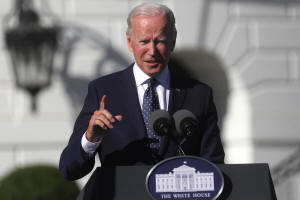Explainer-Could Biden steer the U.S. Senate into changing the
filibuster?
 Send a link to a friend
Send a link to a friend
 [October 23, 2021]
By Susan Cornwell [October 23, 2021]
By Susan Cornwell
WASHINGTON (Reuters) - U.S. President Joe
Biden has sounded increasingly open over the past month to changing the
Senate's filibuster tradition to bypass a Republican roadblock that has
imperiled key aspects of the Democratic agenda.
After long opposing change, Biden, who spent 36 years in the Senate,
said on Thursday the chamber should "fundamentally alter" the
long-standing process requiring 60 of the 100 senators to agree on most
legislation, which Republicans have used to block voting-rights bills
and which brought the country perilously close to a crippling debt
default earlier this month.
Democrats could use their razor-thin Senate majority to eliminate or
change the rule, though it would require the agreement of all of their
members, including moderates Joe Manchin and Kyrsten Sinema, who have
voiced objections.
WHAT IS THE FILIBUSTER?

To "filibuster" means to delay action on a bill or other issue by
talking.
The Senate filibuster first captured the American imagination in Frank
Capra's 1939 movie "Mr. Smith Goes to Washington," when Jimmy Stewart's
character spoke for more than a day, and more recently in 2013 when
Texas state Senator Wendy Davis spoke for 13 hours to try to block a
bill imposing new restrictions on abortion.
The popular image of a lone lawmaker mounting an impassioned hours-long
argument belies the reality in today's Senate, where a mere threat is
enough to initiate a filibuster and hold up a bill.
A filibuster can only be stopped if a supermajority of 60 senators votes
to end debate in a process called cloture.
WHY IS THE RULE A PROBLEM FOR DEMOCRATS?
With just 50 senators in their caucus, Democrats currently can't
overcome filibusters unless at least 10 Republicans vote with them.
Democrats were able to pass Biden's $1.9 trillion COVID-19 stimulus plan
without a supermajority through another Senate maneuver called
"reconciliation," with the help of Vice President Kamala Harris's
tie-breaking 51st vote. But the rules limit the use of that process.
Though they did get 19 Republican votes for a $1 trillion package to
revamp the nation's roads, bridges and other infrastructure, Republicans
have blocked many other Democratic priorities, including a voting-rights
measure.
Senate Republicans this year have used the filibuster to block voting
rights legislation that Democrats want to counter new restrictions
passed in Republican-led states by supporters of Donald Trump's false
claims that his November 2020 election defeat was due to widespread
fraud.

They are also warning that they could filibuster a vote later this year
to avoid a catastrophic debt default. A prior roadblock on that measure
prompted Biden earlier this month to say he was open to changing the
filibuster.
But he went further at a CNN town hall on Thursday, saying he would
support changing the rule to pass the voting rights measure "and maybe
more," though he said he would not make any moves until after Congress
passes a pair of bills that contain the bulk of his domestic agenda.
WHEN DID THE SENATE ADOPT THE FILIBUSTER RULE?
Although the Constitution makes no mention of filibusters, long-winded
Senate speeches became an increasingly common tactic in the 19th
century.
By 1917, most senators had had enough, agreeing that a vote by a
two-thirds majority could end debate.
[to top of second column]
|

President Joe Biden delivers remarks to honor the Council of Chief
State School Officers' 2020 and 2021 State and National Teachers of
the Year along with U.S. first lady Jill Biden at the White House in
Washington, U.S., October 18, 2021. REUTERS/Leah Millis

But getting two-thirds of the Senate was hard, so
filibusters continued. Notoriously, they were used by Southern
senators who sought to block civil rights laws.
In 1975, the Senate reduced the requirement for
limiting debate to three-fifths of the Senate - currently 60
senators.
In that decade, Senate leadership began agreeing to allow measures
that were facing a filibuster to be put aside while the chamber
acted on other bills.
The move was intended to prevent opposition to a single bill from
bringing all work in the chamber to halt, but it also meant that the
filibuster changed from an energy-draining maneuver involving
lengthy speeches to a mere objection, or threat to object.
Over time the number of filibusters skyrocketed. A count of votes to
try to overcome a filibuster, the nearest reliable proxy, shows 298
such votes in the 2019-2020 legislative session. That's up from 168
such votes in the previous two years. From 1969 to 1970 there were
six.
CAN THE FILIBUSTER BE CHANGED?
There have already been changes.
In 2013, Democrats removed the 60-vote threshold for voting on most
nominees for administration jobs, apart from the Supreme Court,
allowing them to advance on a simple majority vote.
In 2017, Republicans did the same thing for Supreme Court nominees.
Both the 2013 and 2017 changes were made by simple majority votes.

Several filibuster reform ideas have been floated that could stop
short of ending it. They include an exemption just for voting rights
bills, limiting the number of filibusters against any one bill or
forcing those waging a filibuster to remain standing and speaking on
the Senate floor until one side relents.
WHO OPPOSES CHANGE?
Senate Minority Leader Mitch McConnell, for one. At the start of
this year he tried but failed to get an explicit promise from
Democratic Majority Leader Chuck Schumer to protect the filibuster.
"Nobody serving in this chamber can even begin ... to imagine what a
completely scorched-earth-Senate would look like," McConnell said in
March, adding that Republicans would require votes on all
parliamentary moves, drastically slowing the pace of business.
His move earlier this month to allow a vote temporarily raising the
debt ceiling was in part motivated by a desire to protect the
filibuster, according to aides and lawmakers.
(Reporting by Susan Cornwell; Editing by Scott Malone, Aurora Ellis
and Jonathan Oatis)
[© 2021 Thomson Reuters. All rights
reserved.] Copyright 2021 Reuters. All rights reserved. This material may not be published,
broadcast, rewritten or redistributed.
Thompson Reuters is solely responsible for this content.
 |